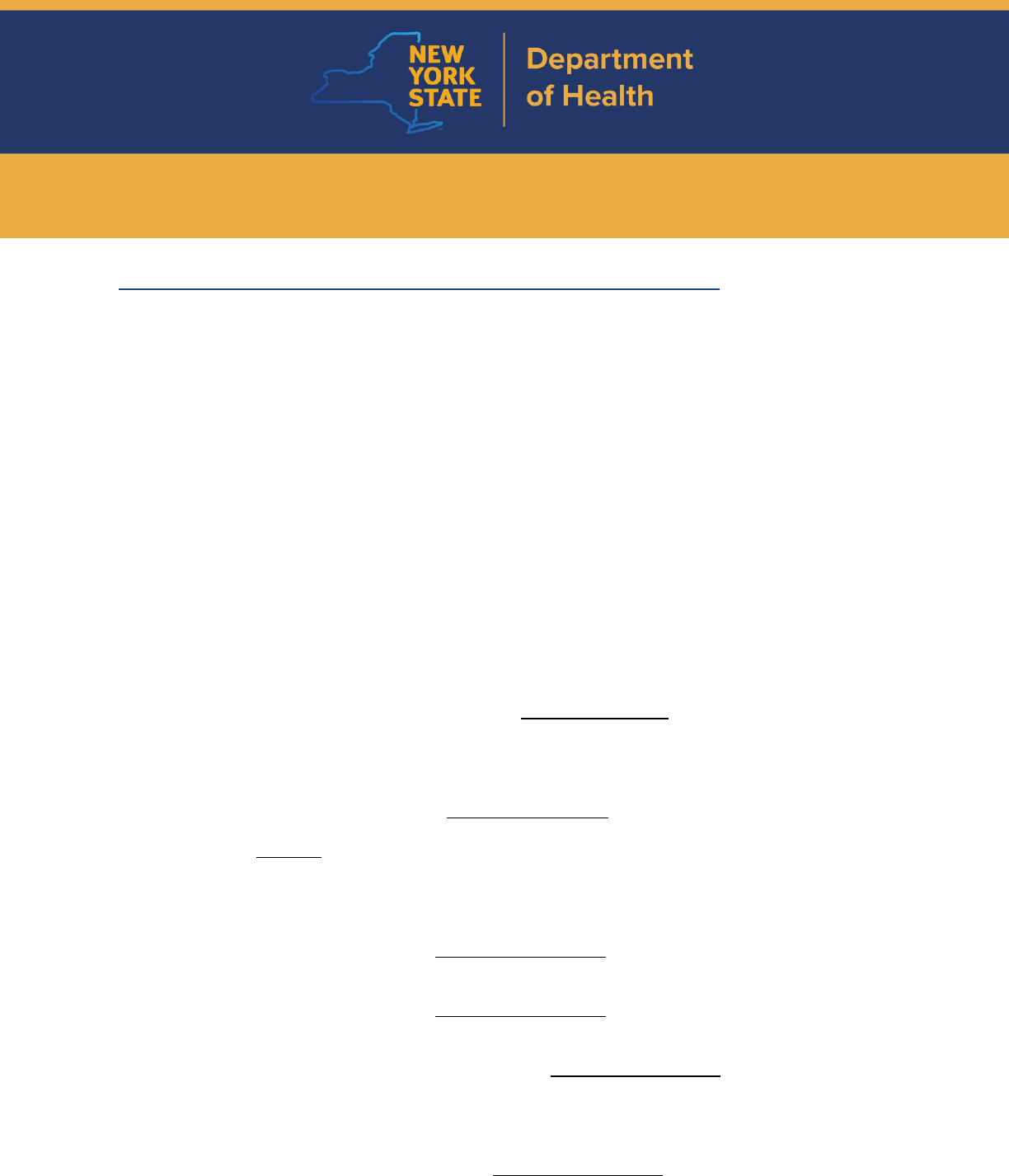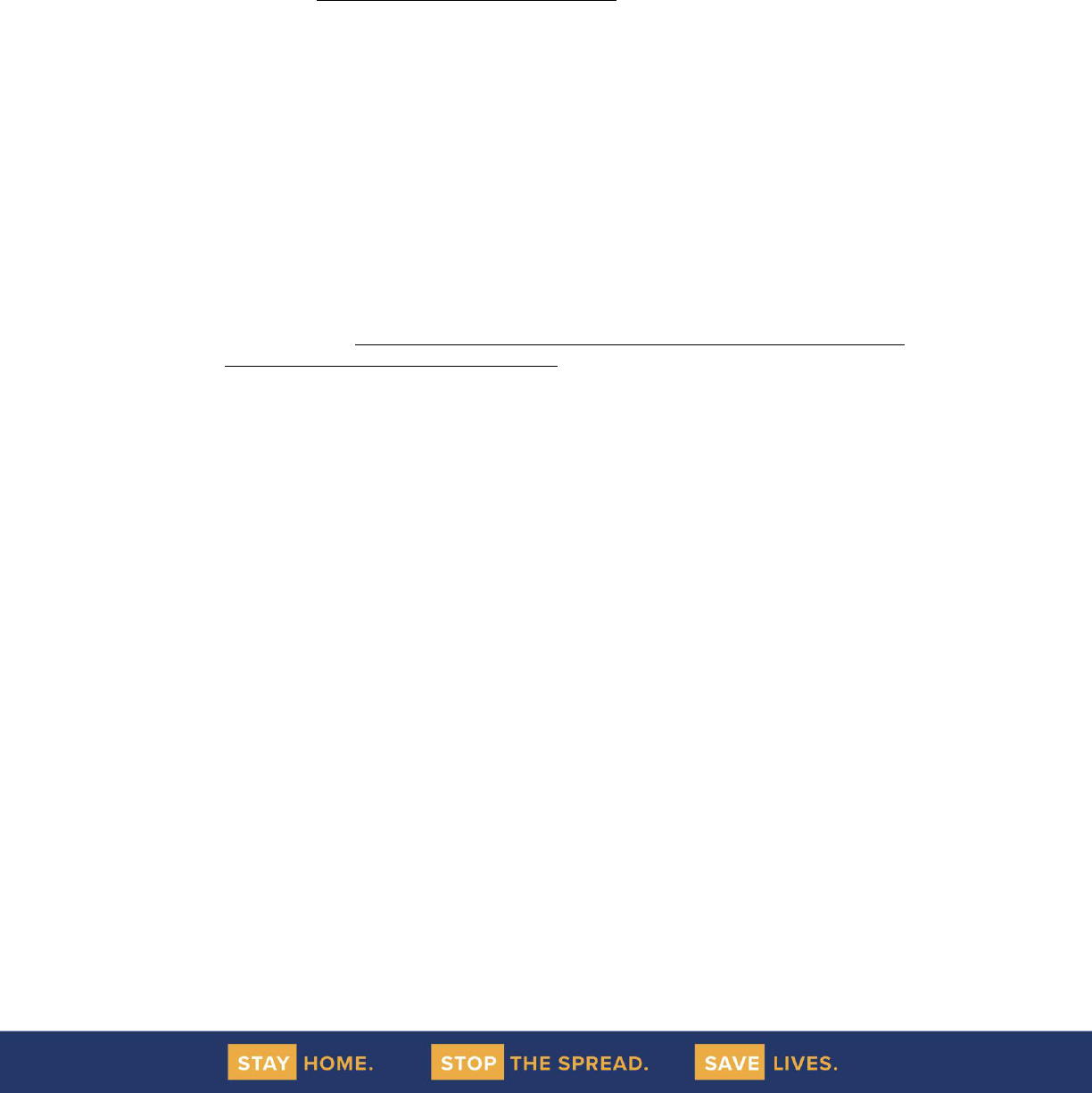
INTERIM GUIDANCE FOR CONSTRUCTION ACTIVITIES
DURING THE COVID-19 PUBLIC HEALTH EMERGENCY
When you have read this document, you can affirm at the bottom.
As of June 26, 2020
Purpose
This Interim Guidance for Construction Activities during the COVID-19 Public Health Emergency (“Interim
COVID-19 Guidance for Construction”) was created to provide owners/operators of construction projects
and their employees and contractors with precautions to help protect against the spread of COVID-19 as
indoor and outdoor construction sites reopen.
These guidelines are minimum requirements only and any employer is free to provide additional
precautions or increased restrictions. These guidelines are based on the best-known public health
practices at the time of Phase I of the State’s reopening, and the documentation upon which these
guidelines are based can and does change frequently. Construction sites must adhere to all local, state
and federal requirements relative to construction activities. All construction-involved entities are also
accountable for staying current with any updates to these requirements, as well as incorporating same
into any construction activities and/or Site Safety Plan.
Background
On March 7, 2020, Governor Andrew M. Cuomo issued Executive Order 202, declaring a state of
emergency in response to COVID-19. Community transmission of COVID-19 has occurred throughout
New York. To minimize further spread, social distancing of at least six feet must be maintained between
individuals, where possible.
On March 20, 2020, Governor Cuomo issued Executive Order 202.6, directing all non-essential businesses
to close in-office personnel functions. Essential businesses, as defined by Empire State Development
Corporation (ESD) guidance, were not subject to the in-person restriction, but were, however, directed to
comply with the guidance and directives for maintaining a clean and safe work environment issued by the
New York State Department of Health (DOH), and were strongly urged to maintain social distancing
measures to the extent possible.
On April 12, 2020, Governor Cuomo issued Executive Order 202.16, directing essential businesses to
provide employees, who are present in the workplace, with a face covering, at no-cost, that must be
used when in direct contact with customers or members of the public during the course of their work.
On April 15, 2020, Governor Cuomo issued Executive Order 202.17, directing that any individual who is
over age two and able to medically tolerate a face-covering must cover their nose and mouth with a
mask or cloth face-covering when in a public place and unable to maintain, or when not maintaining,
social distance. On April 16, 2020, Governor Cuomo issued Executive Order 202.18, directing that
everyone using public or private transportation carriers or other for-hire vehicles, who is over age two
and able to medically tolerate a face covering, must wear a mask or face covering over the nose and
mouth during any such trip. It also directed any operators or drivers of public or private transport to wear
a face covering or mask which covers the nose and mouth while there are any passengers in such a
vehicle. On May 29, 2020, Governor Cuomo issued Executive Order 202.34, authorizing business

2
operators/owners with the discretion to deny admittance to individuals who fail to comply with the face
covering or mask requirements.
On April 26, 2020, Governor Cuomo announced a phased approach to reopen industries and businesses
in New York in phases based upon a data-driven, regional analysis. On May 4, 2020, the
Governor provided that the regional analysis would consider several public health factors, including new
COVID-19 infections, as well as health care system, diagnostic testing, and contact tracing capacity. On
May 11, 2020, Governor Cuomo announced that the first phase of reopening would begin on May 15,
2020 in several regions of New York, based upon available regional metrics and indicators.
In addition to the following standards, both essential and non-essential businesses must continue to
comply with the guidance and directives for maintaining clean and safe work environments issued by
DOH.
Please note that where guidance in this document differs from other guidance documents issued by New
York State, the more recent guidance shall apply.
Standards for Responsible Construction Activities in New York State
No construction activity can occur without meeting the following minimum State standards, as well as
applicable federal requirements, including but not limited to such minimum standards of the Americans
with Disabilities Act (ADA), Centers for Disease Control and Prevention (CDC), Environmental Protection
Agency (EPA), and United States Department of Labor’s Occupational Safety and Health Administration
(OSHA).
The State standards contained within this guidance apply to all construction activities – both essential and
non-essential – in operation during the COVID-19 public health emergency until rescinded or amended by
the State.
The following guidance is organized around three distinct categories: people, places, and processes.
I. PEOPLE
A. Physical Distancing
• For any work occurring indoors (e.g. construction within an existing building), no more than 1 worker
per 250 square feet is allowed on site, excluding supervisors, unless additional personal protective
measures are implemented; or
• A distance of at least six feet must be maintained among workers at all times, unless safety of the
core activity requires a shorter distance (e.g. dry walling, glazing, lifting). Any time employees must
come within six feet of another person, acceptable face coverings must be worn. Employees must be
prepared to don a face covering if another person unexpectedly comes within six feet.
o Acceptable face coverings for COVID-19 include but are not limited to cloth-based face coverings
and disposable masks that cover both the mouth and nose.
o However, cloth, disposable, or other homemade face coverings are not acceptable face coverings
for workplace activities that typically require a higher degree of protection for personal protective
equipment (PPE) due to the nature of the work. For those activities, N95 respirators or other PPE
used under existing industry standards should continue to be used, as is defined in accordance
with OSHA guidelines.

3
• The number of work stations and employee seating areas, and their use, may be modified or
restricted, so that workers are at least six feet apart in all directions (e.g. side-to-side and when
facing one another) and are not sharing workstations without cleaning and disinfection between use.
When distancing is not feasible between workstations, the use of face coverings or physical barriers
(e.g. plastic shielding walls, in lieu of face coverings in areas where they would not affect air flow,
heating, cooling, or ventilation) must be provided and required.
o If used, physical barriers should be put in place in accordance with OSHA guidelines.
o Physical barrier options may include: strip curtains, plexiglass or similar materials, or other
impermeable dividers or partitions.
• The use of small spaces (e.g. elevators, hoists, vehicles) by more than one individual at a time,
unless all employees in such space at the same time are wearing acceptable face coverings, should
be prohibited. However, even with face coverings in use, occupancy must never exceed 50% of the
maximum capacity of the space or vehicle, unless it is designed for use by a single occupant.
Ventilation with outdoor air should be increased to the greatest extent possible, while maintaining
safety protocols, and additional measures to prevent congregation in elevator waiting areas and limit
density in elevators, such as enabling the use of stairs, should be taken.
• Measures should be put in place to reduce bi-directional foot traffic using tape or signs with arrows in
narrow aisles, hallways, or spaces, and post signage and distance markers denoting spaces of six feet
in all commonly used areas and any areas in which lines are commonly formed or people may
congregate (e.g. clock in/out stations, health screening stations, etc.).
• Signs must be posted throughout the site, consistent with DOH COVID-19 signage. Customized
signage specific to a workplace or setting can be developed and used, provided that such signage is
consistent with the Department’s signage. Signage should be used to remind employees to:
o Cover their nose and mouth with a face covering when six feet of social distance cannot be
maintained.
o Properly store and, when necessary, discard PPE.
o Adhere to physical distancing instructions.
o Report symptoms of or exposure to COVID-19, and how they should do so.
o Follow hand hygiene and cleaning and disinfection guidelines.
o Follow appropriate respiratory hygiene and cough etiquette.
B. Gatherings in Enclosed Spaces
• In-person worker gatherings (e.g. shapeups, toolbox talks, safety meetings) must be limited to the
greatest extent possible and other methods such as video or teleconferencing must be used
whenever possible, per CDC guidance “Interim Guidance for Businesses and Employers to Plan and
Respond to Coronavirus Disease 2019 (COVID-19)”. When videoconferencing or teleconferencing is
not possible, meetings should be held in open, well-ventilated spaces and it should be ensured that
individuals maintain six feet of social distance between one another (e.g. if there are chairs, leave
space between chairs, have employees sit in alternating chairs).
• Practices for adequate social distancing in small areas, such as restrooms and breakrooms, must be
put in place, and signage and systems (e.g. flagging when occupied) to restrict occupancy when
social distancing cannot be maintained in such areas should be developed; and

4
• Schedules should be staggered for employees to observe social distancing (i.e., six feet of space) for
any gathering (e.g. coffee breaks, meals, and shift starts/stops).
C. Workplace Activity
• Measures should be taken to reduce interpersonal contact and congregation, through methods such
as:
o limiting in-person presence to only those staff who are necessary to be on site;
o adjusting workplace hours;
o reducing on-site workforce to accommodate social distancing guidelines;
o shifting design (e.g. A/B teams, staggered arrival/departure times);
o prioritizing tasks that allow for social distancing (e.g. steel erection) over those that do not (e.g.
dry walling, glazing); and/or
o avoiding multiple crews and/or teams working in one area by staggering scheduled tasks and
using signs to indicate occupied areas.
D. Movement and Commerce
• Non-essential visitors on site should be prohibited.
• Designated areas for pickups and deliveries must be established, limiting contact to the extent
possible.
• On-site interactions (e.g. designate an egress for workers leaving their shifts and a separate ingress
for workers starting their shifts) and movements (e.g. employees should remain near their
workstations as often as possible) should be limited.
II. PLACES
A. Protective Equipment
• In addition to necessary PPE as required for certain workplace activities, acceptable face coverings
must be procured, fashioned, or otherwise obtained, and such coverings must be provided to
employees while at work at no cost to the employee. An adequate supply of face coverings, masks
and other required PPE should be on hand in the event an employee needs a replacement, or a
visitor is in need. Acceptable face coverings include, but are not limited to, cloth (e.g. homemade
sewn, quick cut, bandana), surgical masks, N95 respirators, and face shields.
• Face coverings must be cleaned or replaced after use and may not be shared. Please consult CDC
guidance for additional information on cloth face coverings and other types of PPE, as well as
instructions on use and cleaning.
o Note that cloth face coverings or disposable masks shall not be considered acceptable face
coverings for workplace activities that impose a higher degree of protection for face covering
requirements. For example, if N95 respirators are traditionally required for specific construction
activities, a cloth or homemade mask would not suffice. OSHA standards for such safety
equipment must be adhered to.

5
• Employees must be allowed to use their own acceptable face coverings, but cannot be required to
supply their own face coverings. Further, this guidance shall not prevent employees from wearing
their personally owned additional protective coverings (e.g. surgical masks, N95 respirators, or face
shields). Compliance with all applicable OSHA standards is required.
• Measures should be put in place to limit the sharing of objects, such as tools, machinery, materials,
and vehicles, as well as the touching of shared surfaces, such as railings and fences; or, require
workers to wear gloves (trade-appropriate or medical) when in contact with shared objects or
frequently touched surfaces; or, require workers to sanitize or wash their hands before and after
contact.
• Workers must be trained on how to adequately put on, take off, clean (as applicable), and discard
PPE, including but not limited to, appropriate face coverings.
B. Hygiene, Cleaning, and Disinfection
• Adherence to hygiene and sanitation requirements as advised by the CDC and DOH, including
“Guidance for Cleaning and Disinfection of Public and Private Facilities for COVID-19,” and the “STOP
THE SPREAD” poster, as applicable, is required. Logs that include the date, time, and scope of
cleaning and disinfection must be maintained.
• Hand hygiene stations must be provided and maintained on site, as follows:
o For handwashing: soap, running warm water, and disposable paper towels.
o For sanitizer: an alcohol-based hand sanitizer containing at least 60% alcohol for areas where
handwashing facilities may not be available or practical.
• Signage should be placed near hand sanitizer stations indicating that visibly soiled hands should be
washed with soap and water; hand sanitizer is not effective on visibly soiled hands.
• Receptacles should be placed around the site for disposal of soiled items, including PPE.
• Appropriate cleaning and disinfection supplies for shared and frequently touched surfaces must be
provided, and employees should be encouraged to use these supplies, following manufacturers’
instructions, before and after the use of these surfaces, followed by hand hygiene.
• Regular cleaning and disinfection of the work site must be conducted, as well as more frequent
cleaning and disinfection for high risk areas used by many individuals and for frequently touched
surfaces. Cleaning and disinfection must be rigorous and ongoing and should occur at least after
each shift, daily, or more frequently as needed. Please refer to DOH’s “Interim Guidance for Cleaning
and Disinfection of Public and Private Facilities for COVID-19” for detailed instructions on how to
clean facilities.
o Regular cleaning and disinfection of restrooms must be ensured. Restrooms should be cleaned
more often depending on frequency of use.
▪ Distancing rules must be adhered to by reducing restroom capacity where feasible.
o Equipment and tools must be regularly disinfected using registered disinfectants, including at
least as often as workers change workstations or move to a new set of tools. Refer to the
Department of Environmental Conservation (DEC) list of products registered in New York State
and identified by the EPA as effective against COVID-19.

6
o If cleaning or disinfection products or the act of cleaning and disinfection causes safety hazards
or degrades the material or machinery, hand hygiene stations must be put in place for in
between uses and/or disposable gloves must be supplied.
• Cleaning and disinfection of exposed areas must be provided for in the event of a positive case of
COVID-19 of a worker, with such cleaning and disinfection to include, at a minimum, all heavy transit
areas and high-touch surfaces (e.g. shared tools, machines, vehicles, handrails, portable toilets).
• CDC guidelines on “Cleaning and Disinfecting Your Facility” if someone is suspected or confirmed to
have COVID-19 are as follows:
o Close off areas used by the person suspected or confirmed to have COVID-19.
▪ Operations do not necessarily need to be closed, if affected areas can be
closed off.
o Open outside doors and windows to increase air circulation in the area.
o Wait 24 hours before you clean or disinfect. If 24 hours is not feasible, wait as long as possible.
o Clean and disinfect all areas used by the person suspected or confirmed to have COVID-19, such
as offices, bathrooms, common areas, and shared equipment.
o Once the area has been appropriately disinfected, it can be opened for use.
▪ Workers without close or proximate contact with the person suspected or confirmed to have
COVID-19 can return to the work area immediately after disinfection.
▪ Refer to DOH’s “Interim Guidance for Public and Private Employees Returning to Work
Following COVID-19 Infection or Exposure“ for information on “close or proximate” contacts.
o If more than seven days have passed since the person suspected or confirmed to have COVID-19
visited or used the facility, additional cleaning and disinfection is not necessary, but routine
cleaning and disinfection should continue.
• Shared food and beverages among employees (e.g. self-serve meals and beverages) must be
prohibited, employees should be encouraged to bring lunch from home, and adequate space for
employees to observe social distancing while eating meals must be identified and reserved.
C. Phased Reopening
• Reopening activities are encouraged to be phased-in so as to allow for operational issues to be
resolved before production or work activities return to normal levels. A limited number of employees
and hours, when first reopening should be considered so as to provide operations with the ability to
adjust to the changes.
D. Communications Plan
• Affirmation that the state-issued industry guidelines have been reviewed, are understood, and that
they will be implemented, must be provided.
• A communication plan for employees, visitors, and customers should be developed that includes
applicable instructions, training, signage, and a consistent means to provide employees with
information. Development of webpages, text and email groups, and social media should be
considered.

7
III. PROCESSES
A. Screening and Testing
• Mandatory daily health screening practices must be implemented.
o Screening practices may be performed remotely (e.g. by telephone or electronic survey), before
the employee reports to the work site, to the extent possible; or may be performed on site.
o Screening should be coordinated to prevent workers from intermingling in close or proximate
contact with each other prior to completion of the screening.
o At a minimum, screening must be required of all workers and visitors and completed using a
questionnaire that determines whether the worker or visitor has:
(a) knowingly been in close or proximate contact in the past 14 days with anyone who has
tested positive for COVID-19 or who has or had symptoms of COVID-19;
(b) tested positive for COVID-19 in the past 14 days; and/or
(c) has experienced any symptoms of COVID-19 in the past 14 days.
• Refer to CDC guidance on “Symptoms of Coronavirus” for the most up to date information on
symptoms associated with COVID-19.
• Employees must be required to immediately disclose if and when their responses to any of the
aforementioned questions change, such as if they begin to experience symptoms, both during work
hours or outside of work hours.
• In addition to the screening questionnaire, temperature checks may also be conducted per Equal
Employment Opportunity Commission or DOH guidelines. Keeping records of employee health data
(e.g. the specific temperature data of an individual) is prohibited, but maintaining records that
confirm individuals were screened and the result of such screening (e.g. pass/fail, cleared/not
cleared) is permitted.
• Any personnel performing screening activities, including temperature checks, must be appropriately
protected from exposure to potentially infectious workers or visitors entering the site. Personnel
performing screening activities should be trained by employer-identified individuals who are familiar
with CDC, DOH, and OSHA protocols.
• Screeners should be provided and use PPE, including at a minimum, a face mask, and may include
gloves, a gown, and/or a face shield.
• An individual who screens positive for COVID-19 symptoms must not be allowed to enter the worksite
and must be sent home with instructions to contact their healthcare provider for assessment and
testing.
o Information on healthcare and testing resources should be provided to such individuals.
o The state and local health department must be immediately notified about the case if test results
are positive for COVID-19.
• Refer to DOH’s “Interim Guidance for Public and Private Employees Returning to Work Following
COVID-19 Infection or Exposure” regarding protocols and policies for workers seeking to return to

8
work after a suspected or confirmed case of COVID-19 or after the worker had close or proximate
contact with a person with COVID-19.
• A central point of contact, which may vary by activity, location, shift or day, must be designated as
responsible for receiving and attesting to having reviewed all questionnaires, with such contact also
identified as the party for individuals to inform if they later are experiencing COVID-19-related
symptoms, as noted on the questionnaire.
• A site safety monitor must be designated whose responsibilities include continuous compliance with
all aspects of the site safety plan.
• To the extent possible, a log of every person, including workers and visitors, who may have close or
proximate contact with other individuals at the work site or area must be maintained; excluding
deliveries that are performed with appropriate PPE or through contactless means. Log should contain
contact information, such that all contacts may be identified, traced and notified in the event an
employee is diagnosed with COVID-19. Cooperation with state and local health departments contact
tracing efforts is required.
B. Tracing and Tracking
• The state and local health department must be notified immediately upon being informed of any
positive COVID-19 test result by a worker at the site.
• In the case of a worker or visitor testing positive, cooperation with the state and local health
department is required to trace all contacts in the workplace, and the state and local health
department must be notified of all workers and visitors who entered the site dating back to 48 hours
before the worker began experiencing COVID-19 symptoms or tested positive, whichever is earlier,
but confidentiality must be maintained as required by federal and state law and regulations.
• State and local health departments may, under their legal authority, implement monitoring and
movement restrictions of infected or exposed persons including home isolation or quarantine.
• Employees who are alerted that they have come into close or proximate contact with a person with
COVID-19, and have been alerted via tracing, tracking or other mechanism, are required to self-
report to their employer at the time of alert and shall follow the protocol referenced above.
IV. EMPLOYER PLANS
Completed safety plans must be conspicuously posted on site. The State has made available a business
reopening safety plan template to guide business owners and operators in developing plans to protect
against the spread of COVID-19.
Additional safety information, guidelines, and resources are available at:
New York State Department of Health Novel Coronavirus (COVID-19) Website
https://coronavirus.health.ny.gov/
Centers for Disease Control and Prevention Coronavirus (COVID-19) Website
https://www.cdc.gov/coronavirus/2019-ncov/index.html

